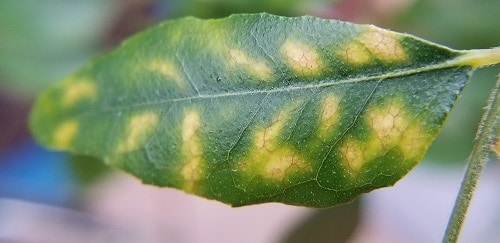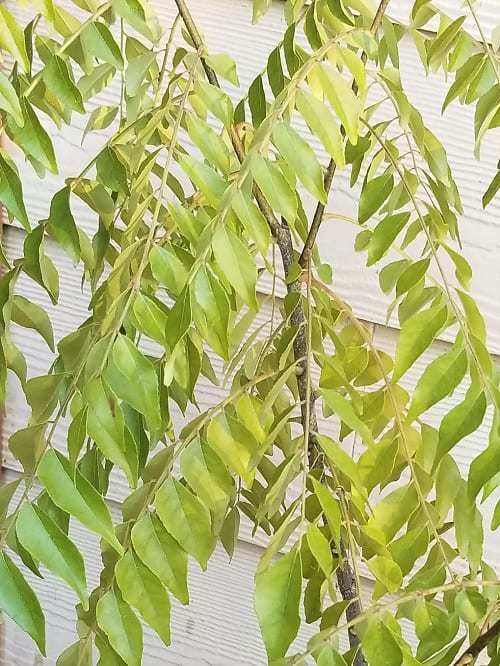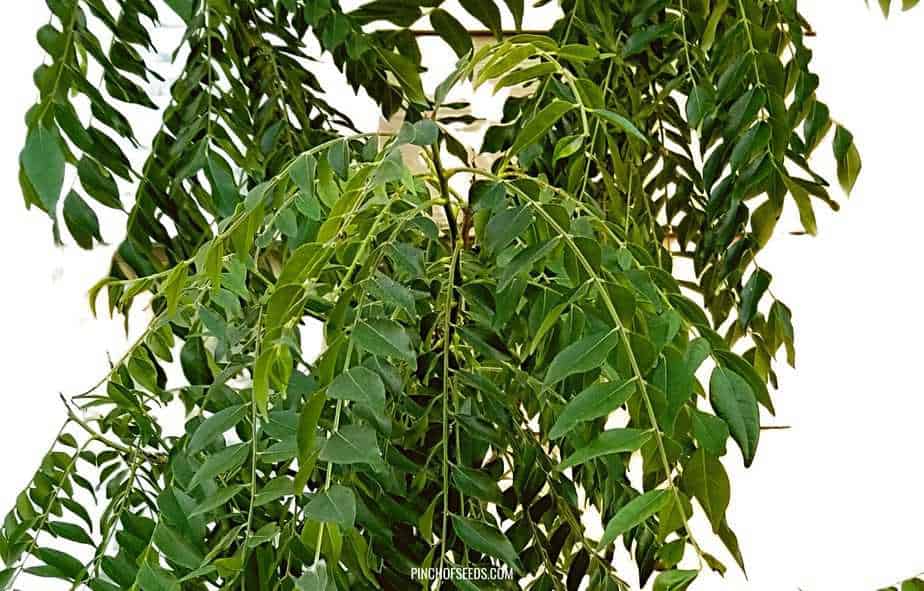Without a doubt, a Curry Leaf Plant is the most precious plant in any Indian kitchen garden. All of us want our curry leaf plant which is also known as ‘Kadi Patta’ to grow faster, bushier, and greener than what it is. Most of the readers of the article How to Transplant a Curry Leaf Plant ask me three questions: How do I grow curry leaves faster? How do I fertilize a curry leaf plant? And what is the best natural fertilizer for the Curry leaf plant? Well, let me share a secret with you: most of the fertilizers for your Curry leaf plant can be homemade, right in your kitchen!
How to Fertilize Curry Leaf Plant: Curry leaf plant benefits significantly from regular feedings of fertilizers higher in Nitrogen (N) value. Apply one application of Blood Meal in the spring, followed by monthly applications of Seaweed or Fish fertilizer. Curry Leaf plant also responds positively to homemade fertilizers like Buttermilk, Rice water, Asafoetida, and eggshells, which can be applied weekly.
Curry Leaf Plant growing in-ground doesn’t require a lot of fertilizers. It gets most of the nutrients and minerals from the soil. When growing in a container, the nutrients and minerals from potting soil wash away with the regular watering. That’s why you should follow a fertilizer schedule to make your curry leaf plant healthier, bushier, and grow faster.

Let’s review the best fertilizer options for the Curry leaf plant, how they help the curry leaf plant, and how to apply them.
Best Homemade Fertilizers for Curry Leaf Plant:
Buttermilk
Is buttermilk good for curry leaf plant? Yes, there are multiple reasons why buttermilk is an excellent homemade fertilizer for a curry leaf plant. Buttermilk is high in Nitrogen, which curry leaf plant needs. Buttermilk makes the soil acidic, which curry leaf plant loves. Lastly, buttermilk contains probiotic bacteria, which not only increases the soil’s microbe level but also helps the curry leaf plant fight the fungal infections like black spots and powdery mildew.
How to Apply:
– Let the soil of the container dry out a little before the buttermilk application.
– Mix 2 tablespoons of sour yogurt or curd into 1 gallon of water.
– Pour the mixture at the base of the curry leaf plant.
– Apply weekly.
Rice Water
Why: For many generations, gardeners in India give washed rice liquid to the curry leaf plant. It is believed that the unpolished rice contains a high level of Vitamin B, which may stimulate new root growth. Some scientific views prove otherwise, but it wouldn’t hurt to try and find out for yourself!
How to Apply:
– When washing white or brown rice for cooking, save the water.
– Pour the water at the base of the curry leaf plant.
– Can apply rice water instead of regular watering.
Asafoetida
Why: Asafoetida (AKA ‘Hing’) promotes new top shoots and baby leaves on the curry leaf plants. Although there is no scientific research supporting this belief, many gardeners use Asafoetida as a growth stimulant for curry leaf plants and are happy with the results. For better results, apply Asafoetida together with the buttermilk mixture.
How to Apply:
– Prepare the buttermilk mixture, as described above.
– Add ¼ teaspoon of powdered Asafoetida into the mixture.
– Mix well.
– Pour the mixture at the base of the curry leaf plant.

Eggshells
Why: Crushed eggshell provides Calcium- one of the critical nutrients for the plant’s well-being. Calcium promotes vigorous growth as well as green foliage and a robust root system. No wonder eggshells are one of the best homemade fertilizers for curry leaf plant!
How to Apply:
– Save 2 to 3 eggshells in a Ziplock bag.
– Crush the eggshells. Sprinkle the eggshells on the surface of the soil.
– Mix the top 1” to 2” of soil carefully, making sure not to damage the roots.
– Can be applied every 2 to 3 weeks.


Best Natural and Organic Fertilizers for Curry Leaf Plant:
Homemade fertilizers are good for curry leaf plant, but they are not enough by themselves. You should apply at least one of the liquid fertilizer (for quick drink of nutrients) and one of the granular/solid fertilizer (for long term feeding) from the list below for optimum growth of the curry leaf plant.
Fish Emulsion and Fish fertilizer
Why: Curry leaf plant is mainly harvested for its leaves. To grow lush green leaves, curry leaf plant needs more amount of Nitrogen. Fish emulsion is an organic, liquid fertilizer which has high Nitrogen value but also contains some amount of Phosphorus and Potassium. Most of the fish emulsion fertilizers like Alaska Fish fertilizer has a nutrition value of 5-1-1. Fish fertilizers also contain many trace minerals that are beneficial to most of the plants in any garden. Liquid fertilizers like the Fish emulsion are readily available for the plants to be absorbed and thus provides quicker results than granular fertilizers.
How to Apply:
– Follow the direction on the product label.
– If no clear direction provided, mix 2 tablespoons of the product with 1 gallon of water.
– Pour at the base of the curry leaf plant.
– It can be used as a foliar application -Spray on top and bottom of the leaves.
– Make sure to apply outside as the Fish products smell pretty bad.
– Apply every other week; skip when any additional fertilizer is applied in the last 4-6 days.
Seaweed Fertilizer
Why: If you want to make your curry leaf plant grow faster, apply seaweed fertilizer every 15 days. Seaweed or Kelp fertilizers contain more than 60 trace minerals from the ocean. Not only that, but they are also valuable as a growth stimulant because of the presence of multiple growth hormones. These fertilizers are available in liquid as well as in powder forms.
Seaweed is a plant-based, organic fertilizer option for the vegetarian or vegan growers who do not want to apply any animal-based fertilizers to their curry leaf plants.
To fertilize my curry leaf plant, I use Neptune’s Harvest Seaweed and Fish fertilizer. It not only has growth stimulants from Seaweed but has the goodness of fish fertilizer as well. Best of both worlds! This can be used for fertilizing seedlings as well as fertilizing tomatoes growing in the garden.
How to Apply:
– Follow the direction on the product label.
– If no clear direction provided, mix 2 tablespoons of the product with 1 gallon of water.
– Pour at the base of the curry leaf plant.
– It can be used as a foliar application -Spray on top and bottom of the leaves.
– Apply every other week; skip when any additional fertilizer is applied in the last 4-6 days.
Blood Meal
Why: Blood meal has about 10 to 12% of Nitrogen, which helps curry leaf plants grow more leaves. Blood meal takes a few weeks to break down. So, it is best to supplement it with liquid fertilizers to provide both long term nourishment and quickly accessible nutrients for the optimum growth of the curry leaf plant.
How to Apply:
– In early spring, add 1 tablespoon of blood meal to the potting soil (for 14” diameter pot); add proportionately more for a larger pot.
– Mix the top layer of soil gently, without damaging the roots.
– Water thoroughly.
Cow Manure:
Why: While providing key nutrients to the Curry leaf plant, cow manure also helps improve the soil structure. It makes the compact and heavy clay soil loose for easier root penetration. Plus, it also helps in retaining water in the potting soil. Make sure the cow manure is properly ‘baked’ or dehydrated, otherwise it can burn the curry leaf plant.
How to Apply:
– Add a trowel full of manure to the potting soil (for 14” diameter pot); add proportionately more for a larger pot.
– Mix the top layer of soil gently, without damaging the roots.
– Water thoroughly. It can be reapplied mid-season.
– Do not apply to a curry leaf plant that is less than 1 year old- it can burn the plant.
Additional Nutrients for Curry Leaf Plant:
In addition to the fertilizers, which provides the essential nutrients (N-P-K), Curry leaf plant needs three supplemental nutrients- Iron, Magnesium, and Calcium. Here is why and how to apply them:
Chelated Iron

Why: Curry leaf plants are known to be Iron deficient quite frequently. You will know if your curry leaf plant needs Iron if the leaves of the plant turn yellow, but the veins of the leaves stay green. One of the reasons for Iron deficiency is the higher Ph level of the soil. Curry leaf plant loves acidic soil, so maintain the Soil Ph between 6.4 to 6.9.
Chelated Iron is an altered form of Iron that is easier for the plants to absorb and digest. Thus showing quicker results than the powdered Iron.
How to Apply:
– Follow the product label for direction.
– It can be applied as soil saturation or as a foliar spray.
– Apply every three months if also feeding the buttermilk solution Or apply every two months until early fall.
Epsom salt

Why: If your curry leaf plant is lacking the lush green color, or looks yellowish all over, it may have become Magnesium deficient. Epsom salt is a household name for ‘Magnesium Sulfate.’ It contains Magnesium and sulfur. Though by itself, Epsom salt is not a fertilizer, it provides essential nutrients to enhance the effect of fertilizers. Epsom salt helps plants increase chlorophyll production and helps restore the green color of the leaves.
How to Apply:
– Dissolve 2 Tablespoons of Epsom salt per 1 gallon of water.
– Pour the mixture gently at the base of the curry leaf plant.
– It can also be applied as a foliar spray- soak the leaves by spraying the solution directly on the leaves.
– Apply monthly until early fall.
Gypsum:
Why: Gypsum is an excellent source of Calcium, another critical nutrient that is essential for the overall growth and development of the curry leaf plant. It aids in root and leaf development.
How to Apply:
– Follow the product direction
– Spread Gypsum on top of the potting soil.
– Mix the top layer of soil gently, without damaging the roots. Water thoroughly.
– Apply every other month. Do not overlap the application with Iron application.
Keep at least a one month gap between Iron application and Gypsum application.
Tips for Fertilizing Curry Leaf Plant for the best growth:
- For the best result, you should balance between solid (or granular) fertilizer and liquid fertilizers. Don’t overdo it. It is okay to underfeed the plant than over-fertilizing it.
- After pruning the curry leaf plant, wait for 2 to 3 weeks before fertilizing it.
- Stop fertilizing about a month before the plant needs to be moved inside for the winter.
- Apply fertilizers only during the growing season when the plant is outdoors. During the winter months, while indoors, Curry leaf plant doesn’t need fertilization.
- Apply foliar sprays on cool, cloudy days. Scorching sun can burn the leaves soaked by the foliar spray.
- Do not apply fish fertilizer when the plant is indoors. It will stink up the entire house.
- Water the plant regularly, but let the soil dry out slightly before applying fertilizer. A thirsty soil will soak up the nutrients faster than the water-saturated soil.
- Keep your pets away from the curry leaf plant for a few days after applying fertilizers. Some of the fertilizers have heavy smell of fish, bone and eggs. Your pet may get curious and start to dig the soil.
- Curry leaf plant can be infested with Scales, Aphids and ants. Use Neem Oil Insecticide which can also help in fighting black spots on the leaves.
Want to know more about growing a Curry Leaf Plant?
- How to care for a Curry Leaf Plant
- 3 Things to Consider Before Buying a Curry Leaf Plant
- How to Transplant a Curry Leaf Plant
- How to prune a curry leaf plant to make it bushy
Ask your questions:
If you have any question regarding growing curry leaf plant, please leave a comment below. Or connect with me on Pinch of seeds group on Facebook. You can ask questions, post a picture for photo consultation, get personalized response and interact with other gardeners.
Last updated: 9/14/2020


Hi.
Why are the leaves of my curry leaf tree going black?
Thank you.
Hi.
Why are the leaves of my curry leaf tree going black.
Please help.
Thank you
Hi Gopi! I was so delighted to come across your informative site! Thank you for all of your knowledge and experience. So I live in NYC and my curry leaf plants don’t get a lot of outdoor time during the warm months. So my question is, when is a good time to fertilize with either the buttermilk or eggshells since my plants are indoors? Your comments above say to stop fertilizing when the plants come indoors, but you see my dilemma..
Thanks
Hi Shamala, I see your dilemma. Since the Curry leaf plant is indoor most of the time, it won’t grow as fast as it would be if outdoors. The plant’s nutritional requirements would also be less. So you can apply buttermilk or eggshell every 2-3 weeks, alternating between the buttermilk and eggshells. Do allow time in-between this applications for the plant to absorb the nutrients and process them. Providing artificial light would help the plant grow faster.
Hope this help!
– Gopi
Hello. Thanks for sharing such useful information.
I want to know.. if I regularly fertilize with home made compost from kitchen waste, will it be sufficient?
Hi Seema!
Most likely that should be enough for the curry leaf plant. But it is always a good idea to rotate the fertilizers to provide variety of nutrients to the plants.
-Gopi
I have a young curry leaf plant that was growing fine until a month ago. Suddenly the stop foliage started to droop and the top inch of main trunk started becoming black. I cut the top inch off but then again the top is starting to get black. There are no leaves on it now. I live in Chicago USA and brought my plant indoors before fall. Please advise.
Hi Farah,
It seems like the roots has started rotting. Reduce watering to see if that improves the condition. You may have to wait till spring to see any improvement.
– Gopi
Hi Gopi,
So I have been growing few curry leave plants since last October and it’s one year now. I have been very patient with them as I was growing them to give them as gifts to my friends. I planted freshly harvested seeds. From egg container to different pots few have survived but didn’t grow 10 inches tall except two of them. Last week I planted two of them in the ground thinking they might grow faster in the ground. Yesterday only, when I was searching how to prune my plants for faster growth, I found your blog and thank god I didn’t prune them. My question is, since winter is coming and they are not tall enough and I can’t prune them, how will they survive freezing temperatures in night. I live in Arizona and I have seen plants and trees dying because of freezing temperatures in this desert.
Hello KK,
If your area gets any freeze during cold season, the curry leaf plant should stay in a container only. That way you can bring the pot in or out based on the weather. Here is a detailed guide on how to take care of the curry leaf plant in different seasons.
Thanks Gopi,
The link you sent is very helpful!
Miss Gopi,
Thx and appreciate for your prompt response. As per your answer please let me know in April 2021 in which Curry Leaf Plant is ready.
I am living in Austin TX .
Vijay S Patel
Thanks for the blog Gopi, very informative. I have a question regarding pruning. I bought my plant this year and it is 15 to 20 inches tall. I haven’t pruned it yet. With winter coming up soon in Atlanta, can I prune them now before taking them indoors or will that hurt since the growing season is over. I am planning to keep them with grow lights indoors.
Hi Vivek,
The best time to prune a curry leaf plant is early Spring, when plant is taken outdoors. When the curry leaf plant is pruned, it will grow new branches from just below the cut. That new growth requires warm and humid weather to develop new, lush growth, which will be naturally better provided in Spring.
Since you are planning to keep the curry leaf plant inside, I would suggest to wait till late March/early April to prune the curry leaf plant.
You may find this detailed guide helpful to prepare the curry leaf plant for winter months:
‘How to take care of Curry Leaf Plant in each season’
Hope this helps! Good luck!
– Gopi
Sister,
Thx for providing very good and effective guidance for growing Curry Leaf Plant. I read throughout the thread. I think you gave information in all respects for growing this plant.
I am a Civil Engr ( B . E . ( CIVIL).
I arrived in U S last week of Sept 20.
I brought dried seeds of Curry Leaf Plant two months old after harvesting.
Mi question is how to plant seeds though they are dried ?
Thx
Vijay Patel
Hello Vijaybhai!
Welcome to USA!
In my experience, curry leaf seeds sprouts only when planted shortly after harvesting. Completely dried Curry leaf seeds won’t germinate.
I would suggest to buy a small curry leaf plant in Spring for the better (and faster) result. You can contact me in April if you want one.
Good luck!
– Gopi
Hello Gopi, I came across your site while searching to transplant an adult curry leaf plant from garden to a pot. Thank you for sharing amazing tips to take care of the plant. I’ll follow the transplant tips and keep my fingers crossed.
Keep up the great work and keep sharing!
Thank you again!
Thanks for taking time to comment with encouraging words! Appreciate it!
Thank you Gopi for your tips and throughly knowledge of curry leaves plant fertilizers.
I have few curry leaf plants.They are still babies,I will definitely follow your guidance on them and hope it will work and hope I will do it in right manner (which is most important 🙂 ).
I am not good in gardening but with all your guidelines and help I am leaning eventually.
THANK YOU
Thank you for your kind words, Pinal! I am glad you find it helpful.
– Gopi
Hello. My curry leaf plant is 3 years old and is one meter tall. No branches at all. The trunk is woody. What should I do to grow branches?
Hello Nalini,
It seems like the plant has not be pruned or trimmed yet. In spring, cut about one third of the plant from the top. In just a few days, new branches will start coming out from just below the cut. Keep cuttin gthe new branches in half every Spring, and you will have a bushy plant soon!
Hope this helps!
– Gopi